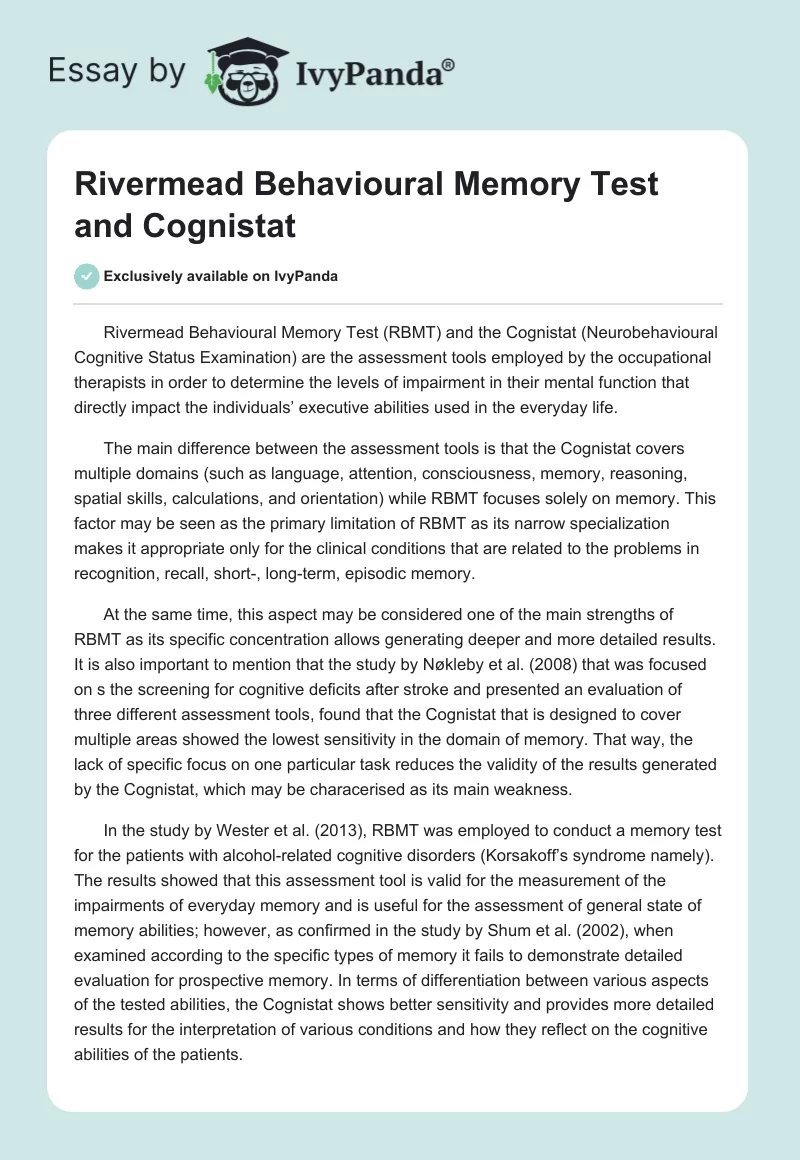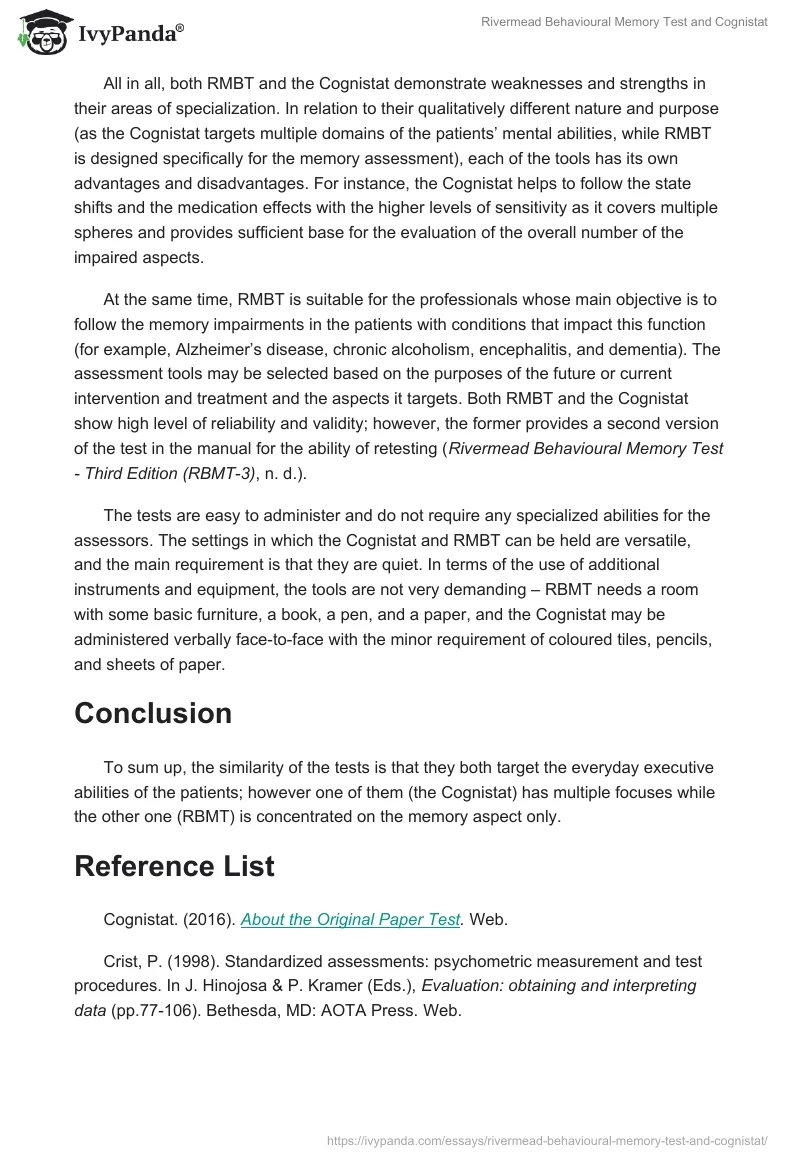Rivermead Behavioural Memory Test (RBMT) and the Cognistat (Neurobehavioural Cognitive Status Examination) are the assessment tools employed by the occupational therapists in order to determine the levels of impairment in their mental function that directly impact the individuals’ executive abilities used in the everyday life.
The main difference between the assessment tools is that the Cognistat covers multiple domains (such as language, attention, consciousness, memory, reasoning, spatial skills, calculations, and orientation) while RBMT focuses solely on memory. This factor may be seen as the primary limitation of RBMT as its narrow specialization makes it appropriate only for the clinical conditions that are related to the problems in recognition, recall, short-, long-term, episodic memory.
At the same time, this aspect may be considered one of the main strengths of RBMT as its specific concentration allows generating deeper and more detailed results. It is also important to mention that the study by Nøkleby et al. (2008) that was focused on s the screening for cognitive deficits after stroke and presented an evaluation of three different assessment tools, found that the Cognistat that is designed to cover multiple areas showed the lowest sensitivity in the domain of memory. That way, the lack of specific focus on one particular task reduces the validity of the results generated by the Cognistat, which may be characerised as its main weakness.
In the study by Wester et al. (2013), RBMT was employed to conduct a memory test for the patients with alcohol-related cognitive disorders (Korsakoff’s syndrome namely). The results showed that this assessment tool is valid for the measurement of the impairments of everyday memory and is useful for the assessment of general state of memory abilities; however, as confirmed in the study by Shum et al. (2002), when examined according to the specific types of memory it fails to demonstrate detailed evaluation for prospective memory. In terms of differentiation between various aspects of the tested abilities, the Cognistat shows better sensitivity and provides more detailed results for the interpretation of various conditions and how they reflect on the cognitive abilities of the patients.
All in all, both RMBT and the Cognistat demonstrate weaknesses and strengths in their areas of specialization. In relation to their qualitatively different nature and purpose (as the Cognistat targets multiple domains of the patients’ mental abilities, while RMBT is designed specifically for the memory assessment), each of the tools has its own advantages and disadvantages. For instance, the Cognistat helps to follow the state shifts and the medication effects with the higher levels of sensitivity as it covers multiple spheres and provides sufficient base for the evaluation of the overall number of the impaired aspects.
At the same time, RMBT is suitable for the professionals whose main objective is to follow the memory impairments in the patients with conditions that impact this function (for example, Alzheimer’s disease, chronic alcoholism, encephalitis, and dementia). The assessment tools may be selected based on the purposes of the future or current intervention and treatment and the aspects it targets. Both RMBT and the Cognistat show high level of reliability and validity; however, the former provides a second version of the test in the manual for the ability of retesting (Rivermead Behavioural Memory Test – Third Edition (RBMT-3), n. d.).
The tests are easy to administer and do not require any specialized abilities for the assessors. The settings in which the Cognistat and RMBT can be held are versatile, and the main requirement is that they are quiet. In terms of the use of additional instruments and equipment, the tools are not very demanding – RBMT needs a room with some basic furniture, a book, a pen, and a paper, and the Cognistat may be administered verbally face-to-face with the minor requirement of coloured tiles, pencils, and sheets of paper.
Conclusion
To sum up, the similarity of the tests is that they both target the everyday executive abilities of the patients; however one of them (the Cognistat) has multiple focuses while the other one (RBMT) is concentrated on the memory aspect only.
Reference List
Cognistat. (2016). About the Original Paper Test. Web.
Crist, P. (1998). Standardized assessments: psychometric measurement and test procedures. In J. Hinojosa & P. Kramer (Eds.), Evaluation: obtaining and interpreting data (pp.77-106). Bethesda, MD: AOTA Press. Web.
Fricke, J. (1993). Measuring outcomes in rehabilitation: A review. British Journal of Occupational Therapy, 56(6), 217-221. Web.
Law, M. (1987). Measurement in Occupational Therapy: Scientific Criteria for Evaluation. Canadian Journal of Occupational Therapy, 54(3), 133-138. Web.
Makatura, T., Lam, C. S., Leahy, B. J., Castillo, M. T., & Kalpajian, C. Z. (1999). Standardised memory tests and the appraisal of everyday memory. Brain Injury, 13(5), 355-367. Web.
Man, D., Tam, S., & Hui-Chan, C. (2006). Prediction of functional rehabilitation outcomes in clients with stroke. Brain Injury, 20(2), 205-211. Web.
Nicks, R. (2007). The Cognistat is a sensitive measure for screening and identifying people with cognitive impairment following ABI in acute hospital settings. Web.
Nokleby, K., Boland, E., Bergersen, H., Schanke, A., Farner, L., Wagle, J., & Wyller, T. (2008). Screening for cognitive deficits after stroke: a comparison of three screening tools. Clinical Rehabilitation, 22(12), 1095-1104. Web.
Osmon, D. C., Smet, I., Winegarden, B., Gandhavadi, B. (1992). Neurobehavioral Cognitive Status Examination: Its Use With Unilateral Stroke Patients in a Rehabilitation Setting. Archives of Physical Medicine and Rehabilitation, 73, 414-418. Web.
Rivermead Behavioural Memory Test – Third Edition (RBMT-3). (n. d.). Web.
Shum, D., Fleming, J., & Neulinger, K. (2002). Prospective Memory and Traumatic Brain Injury: A Review. Brain Impairment, 3(1), 1-16. Web.
Wester, A., Herten, J., Egger, J., & Kessels, R. (2013). Applicability of the Rivermead Behavioural Memory Test – Third Edition (RBMT-3) in Korsakoff’s syndrome and chronic alcoholics. Neuropsychiatric Disease and Treatment, 9, 875–881. Web.


